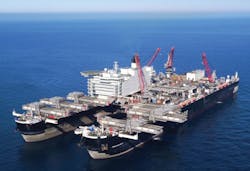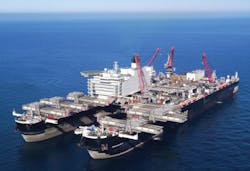Global heavy-lift vessel fleet navigates rough waters during the downturn
Ted Moon
Special Correspondent
What a difference two years can make.Offshore’s 2014 Heavy Lift Vessel survey reported a robust market for heavy-lift vessels in the oil and gas industry, with more vessels coming from new entrants. The 2016 survey finds that, nearly 24 months after the start of the industry downturn, the pace of new vessel construction has slowed as contractors take a more cautious approach to their future expansion plans.
A total of 120 vessels that meet the lifting criterion of at least 100 short tons (st) are included this year, a modest uptick from the 107 vessels in the 2014 survey. Much of this increase comes from companies who are new to the survey, including Allseas and itsPioneering Spirit single-lift installation/decommissioning and pipelay vessel.
Another newcomer is ZPMC-OTL Marine Contractor (ZOMC), a joint venture formed earlier this year by ZPMC Offshore Services Group and OffshoreTech LLC to pursue offshore transportation and installation projects and decommissioning projects. ZOMC added seven vessels to the survey, including theZhen Hua 30, a self-propelled single-boom crane vessel with a main hook lift capacity of 7,700 st in revolving mode and 13,200 st in tie-back mode.
But according to analysis by IHS Markit, a majority of vessels have struggled to stay busy in 2016 - a trend that will likely continue for the foreseeable future.
“We see a major drop in activity this year compared to 2015,” says Genevieve Wheeler Melvin, Senior Research Analyst for IHS Markit, who tracks large vessels with static lift capacities of 1,500 metric tons (1,653 st) or more. “For the first eight months of 2016, about 46% of the large heavy-lift vessels we monitor have been idle.” Add in roughly 17% of in-yard and cold-stack time, and the result is nearly 63% of vessel time classified as non-working days.
“Much of this drop in demand is attributed to a significant slowdown in oil and gas construction activities like topsides installation,” Wheeler Melvin says. “There are far fewer orders for new topsides as operators shift their investment decisions farther out on the horizon.”
Making concessions
These realities forced many vessel contractors to make some painful resizing and cost reduction measures, shedding workers and ships to weather the downturn. Subsea 7, for example, plans to drop five vessels from its active fleet by early 2017, including the heavy-lift vessel theSeven Polaris. This move will save the company approximately $350 million/yr in costs.
With construction work dwindling in the oil and gas industry, many companies are setting their sights in the renewables arena. Some vessel owners have been making headwinds in offshore wind farms, transporting turbine foundations from the dockyard to the final installation site.
Subsea 7, for example, signed a contract in May 2016 to manage, design, engineer, fabricate, and install jacket foundations and array cables for 84 wind turbines at the Beatrice wind farm off the coast of Scotland.
An uptick in decommissioning work in places like the North Sea also promises to give lift vessels some work, particularly large single-lift vessels like thePioneering Spirit or the Saipem 7000. These vessels can perform decommissioning in a single trip, as opposed to time-consuming reverse installation methods that drive up costs.
Vessels are also transporting large shipping cranes and dredging equipment to and from large infrastructure projects in the Middle East. They are also conducting lift work in shipyards, and vessels with large quarters capacity are being used for accommodation support and flotels for offshore workers.
“Unfortunately, there is only so much of this alternative work out there to sustain a large global fleet of heavy-lift vessels,” says Wheeler Martin. “We are not seeing a huge shift in offshore wind farms, shipyards, salvage or accommodations support to make up for the drop in oil and gas construction projects. Only about 13% of vessel days in 2016 have been dedicated to these other activities.”
Complicating matters is the fact that many vessel contractors are bidding on the same projects, making competition tight in a relatively niche market that is still much smaller than oil and gas E&P projects during a boom.
Some positive signs
Although demand for heavy lift has dropped globally and there is a current oversupply of vessels in the market, some contractors are betting on a near-term resurgence by building more vessels.
For example, OOS International recently signed a contract to engineer and build two new semisubmersible crane vessels (SSCVs). NamedOOS Serooskerkeand OOS Walcheren, both vessels will be equipped with two cranes that provide a total dual-lifting capacity of 4,400 tons per vessel. Both SSCVs will include a DP-3 positioning system, accommodate up to 750 personnel, and have a top transit speed of up to 12 knots. The vessels are currently scheduled for completion in 2Q and 3Q 2019.
Big Lift Shipping also plans to add another Happy S-type vessel to its ranks in 2018. TheHappy Sunwill feature two 992-st Huisman heavy lift mast cranes and a lifting height matched only by her sister, the Happy Star.
Heerema Marine Contractors is currently building a semisubmersible crane vessel calledSleipnir in Jurong Shipyard, Singapore. It is scheduled for delivery in 2018.
To learn more about this year’s current global fleet of heavy-lift vessels, peruse theHeavy Lift poster found in this issue of Offshore.

